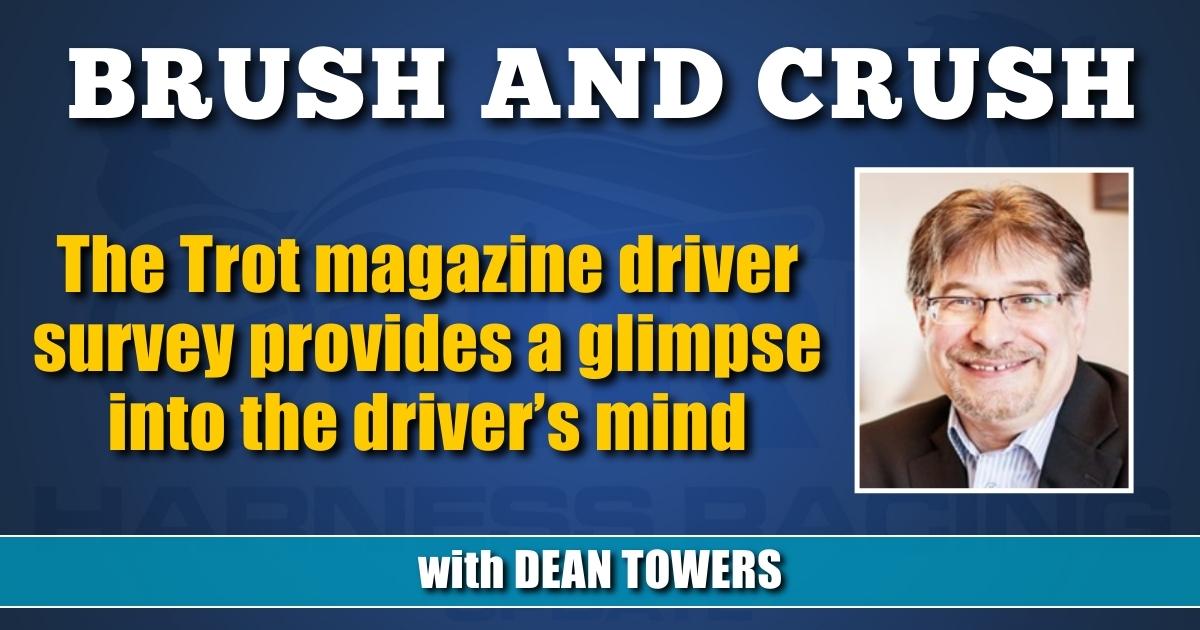The Trot magazine driver survey provides a glimpse into the driver’s mind
by Dean Towers
Bob Marks used to say that when he bets a horse, he owns them for the next two minutes and because of that the driver better be driving for him.
Bob might not be too happy reading the Driver Survey in the April “Horseplayer” Issue of Trot magazine. Because there, only 5 per cent of drivers said they were “mostly thinking about the bettors” when the word go is given (although to temper Bob’s reaction some, 38 per cent did say they were thinking of both owners and bettors).
Reading through this most-interesting piece, put together by Dan Fisher and John Rallis, I found a lot of the answers were about what I expected, but there were a few that raised an eyebrow or two.
On the question: “will you drive horses more aggressively if they’re bet down even if you don’t like their chances” only 19 per cent said they would not. I liked that small percentage, because as a bettor, one thing we do know is the board is the best handicapper on Earth. Although, in this day and age, drivers better be scoring down in front of the tote board late, because those odds can change in a hurry.
“To prevent certain drivers from finishing second or third [to keep their non-winners condition] do you think conditions should be based on earnings?” elicited a 47 per cent agreement. It turns out a good percentage of drivers are just like us bettors: we don’t like the milking of classes either.
I was a bit surprised that 62 per cent of drivers said they only “sometimes” watch replays of a horse they’ve never driven. I expected that number to be super-high because even we as bettors learn so much from watching how a horse performed in his most recent start.
At OTBs or in grandstands everywhere you’ll hear customers complain about haphazard judging and I guess it should not be too shocking that the drivers agree. Only 19 per cent thought the judges were consistent.
Likely because the survey was anonymous, the drivers appeared to be honest regarding their wagering habits. Fifty-seven per cent said they bet sports and only 38 per cent answered they “don’t bet standardbreds.” One in four answered they bet horse racing at least weekly. I had a brief chuckle at those numbers, because at the Hong Kong Jockey Club betting is no bueno and just this week two riders were suspended for wagering.
Drivers were simpatico with betting customers on yet another point: a full 100 per cent believe the sport should be offered as a wagering option via online sports betting sites like Bet365 or FanDuel. Hear, hear.
As for the infamous driver choices we see in the program or on The Meadowlands website each race night, only 10 per cent of drivers said they always pick the horse with the best chance to win. Harness racing has its loyalties and bettors certainly need to pay attention to them.
Drivers are the face of the sport when it comes to the betting customers. Places like Insideharness.com and surveys like the one in last month’s Trot help bridge the gap between them and the customer and in my view it’s all a good thing.
NOTES
We lament people not attending the races regularly, but it’s not just horse racing in the gambling game. Massachusetts recently approved sports betting and in its first month only 3 per cent of handle was retail.
Hawthorne recently lowered win, place, show takeout to an industry low 12 per cent and the results so far have been promising with a reported 34 per cent increase in the pools after 13 race cards.
There was a long-form piece in the Financial Times on the computer bettors who have been making up more and more pool volume that I thought was worth reading. The next time you see your horse drop from 5-1 to 5-2 it’s probably these teams recalibrating the odds board.
The best bet in the world in my view has been the Yonkers seeded pick five. I’ve played it and the card each and every week since it’s been offered. Kudos to the Standardbred Owners Association of New York and Yonkers for trying something new. It’s been good for the customer.
















